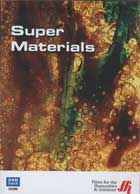
Super Materials 2002, 2006
Distributed by Films Media Group, PO Box 2053, Princeton, New Jersey 08543-2053; 800-257-5126
Produced by Matthey Film
Directed by Udo Tschimmel
DVD, color, 46 min.
Jr. High - Adult
Chemistry, Physics, Technology
Date Entered: 05/09/2007
Reviewed by Jim Hobbs, Online Service Coordinator, Monroe Library, Loyola University, New Orleans, LAIf amazing new materials or nanotechnology pique your interest, consider this film, a European production for the Science Channel. Showing its popular origins, it does not use much technical language and has a “gee whiz” approach, showing unusual applications of and behavior by engineered materials, created in the lab or adapted from natural materials. Researchers and lab technicians work with materials and equipment and applications of artificial materials. It is episodic in nature, with vignettes focusing on one specific example or area of use. The transition from one vignette to another is sometimes abrupt, which may leave the viewer perplexed. The film uses animations to show microscopic behavior. All narrative is done with voiceovers; there are no interviews with experts or researchers.
Super Materials starts with plastics used as building materials. They are described as cheaper than conventional materials and use less energy to produce, corrosion resistant, and lighter. This section abruptly gives way to a new one on silicone as glue and material in consumer products. One example shows the silicone rubber coating of a power cable that can last through very hot fires. The film claims that “materials such as this can save lives” without explanation. There is only a mention of the underlying source of silicones and no discussion of their chemistry or that they are a class of compounds, not a single compound. Additional concrete examples show silicon used in auto paint and nail polish.
The next section is on nanoparticles in paint. The narrative then switches to polymers and back to nanoparticles. An animation on scanning tunneling electron microscopy leads to a discussion of a technique to produce nanoscale tubes, which includes further animation and microphotography.
There is quick switch to memory plastics, which can be restored to their original shape with the application of heat. Examples given are auto body parts that heal with the application of hot air and promises of opening blocked arteries. This gives way to antimicrobial and antifungal plastics, called "SAM polymers." SAM and SAM coatings can prevent the growth of pathogens, shown by technicians examining Petri dishes. Then there is a change to ship hull's vulnerability to damage and corrosion, alleviated with a polyurethane-steel sandwich. One small inaccuracy is a reference to "corrosive steel ribs" rather than "corroded steel ribs."
The following section shows applications of engineered materials in sports: tennis rackets, athletic shoes, kayaks, sails, and mountain bikes, covering many different types of materials. The final section is on organic light-emitting diodes (OLEDs), made from a light-emitting plastic. OLEDs are lightweight and can be used on thin, flexible surfaces with low energy consumption, for bright and fast displays.
This film is suitable for educational use in general chemistry and physics classes from junior high school through the freshman and sophomore level and for others interested in this topic. Some material was reused from the film series The Molecular Universe from the same distributor. There is no menu and no extras.